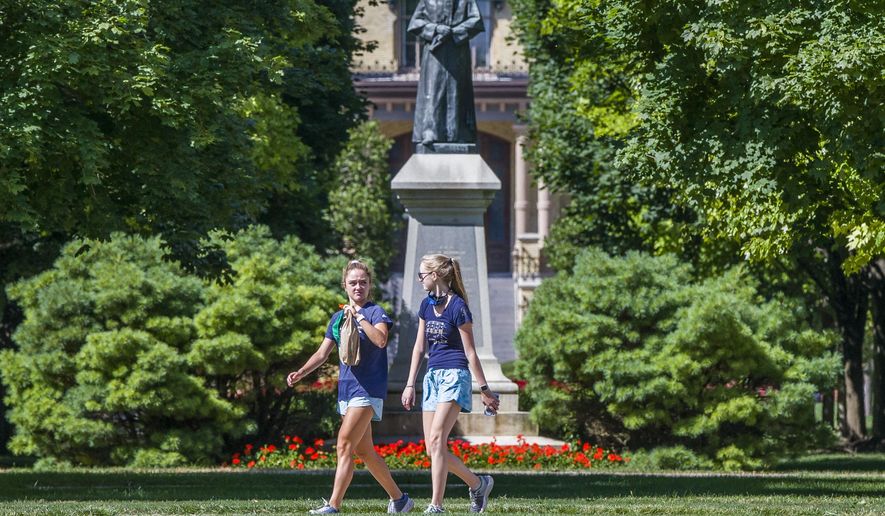Fewer community college students transferred to four-year undergraduate programs this fall and the number is down from pre-pandemic levels, the National Student Clearinghouse Research Center reported Thursday.
So-called “upward transfers” among the new study’s representative sampling of more than 11 million students plummeted by 7.5% or 37,600 students in the fall 2022 semester from fall 2021. They were also down 14.5% or 78,500 students from fall 2020, the first full semester after the COVID-19 pandemic started.
Over the same period, the number of “reverse transfers” from four-year universities to two-year community colleges and “lateral transfers” between the same types of colleges “began to rise,” said the center, which provides educational research to more than 3,600 colleges and universities.
The report confirms that more students are questioning the need for four-year degrees amid a rise in “useless” majors and hiring practices that give little weight to them, said Barry Keating, a finance professor at the University of Notre Dame.
“The perceived value from a four-year degree has fallen in the minds of prospective students,” Mr. Keating said in an email, commenting on the report. “This is true not only for community college students, but also for those individuals considering enrolling directly in four-year institutions.”
Transfers from two-year community colleges to the 200 most highly selective colleges and universities declined faster than transfers into other institutions this fall, dropping 13.4% from 2021 and 20.8% from 2020, the National Student Clearinghouse report found. And most students who transferred into those elite schools came from wealthy families in the top 20% of household incomes nationwide.
“With the upward transfer decline continuing from fall 2021, baccalaureate degree programs appear increasingly out of reach for community college students, particularly those enrolled in urban and suburban community colleges, and in transfer-focused community colleges,” the nonprofit group said in a summary of the findings.
The research center said it produced the Transfer and Progress report with support from the Department of Education and other academic groups to measure pandemic-era impacts on community colleges and provide breakdowns based on student income levels.
According to the report, the drop in community college students opting to pursue a four-year degree was higher among those who finished their associate degree (a decline of 12.7% or 21,700 students) than among those who did not finish their associate degree (a decrease of 4.9% or 16,000 students). And transfers dropped faster in urban and suburban community colleges than in rural programs and those that prepare students for specialized undergraduate vocational training.
That suggests more students from lower income levels are settling for two-year degrees in the pandemic era. But community colleges say it also reflects an overall drop in their enrollments since the pandemic started.
“The transfer rates reported are disappointing but somewhat align with the timing of the pandemic and the subsequent loss of enrollment,” Martha Parham, senior vice president of public relations for the American Association of Community Colleges, said in an email. “We don’t have data that shows why students are choosing not to transfer to universities. We do know that the pandemic impacted community college students more than other students and the effects are still being felt.”
According to the most recent data from the National Student Clearinghouse Research Center, community college enrollments decreased by 7.8% or about 351,000 students from spring 2021 to spring 2022. That’s more than half of the total undergraduate spring enrollment drop of 662,000 or 4.7% that all colleges and universities experienced during the same year-over-year period.
While Thursday’s report found that six-year graduation rates for community college students improved, it also found that transfers by women decreased at a higher rate (3.5%) than by men (0.7%) from fall 2021 to fall 2022. Only students younger than age 20 transferred at higher rates than the year before, with transfers falling in every older age group.
The report also confirms that more students from lower-income families view higher education as an “extraneous expense” as the cost of living “spirals upward” during the pandemic, said Peter Wood, president of the conservative National Association of Scholars. In an email, he pointed out that community college costs also burden students with far less debt than four-year institutions while generating similar job opportunities.
“Only about half the jobs in the U.S. require a college degree and the supply of college graduates far outnumbers the opportunities for jobs that require the degree,” said Mr. Wood, a former associate provost at Boston University. “Combine a steep extra cost with a marginal or no benefit, and it is hardly a surprise that significant numbers of community college graduates are deciding not to pursue the additional degree.”
• Sean Salai can be reached at ssalai@washingtontimes.com.




Please read our comment policy before commenting.